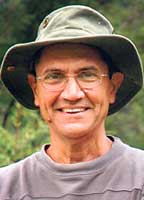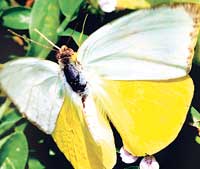The redbay tree may soon face extinction across the Southeast thanks to a rapidly advancing virulent fungus, the causative agent of laurel wilt disease. The trees are an important food source for a variety of wildlife including some popular game birds, deer and songbirds.
The wilt disease, carried by a species of ambrosia beetle that is not native to the United States, has spread rapidly throughout the coastal states since its initial observation in 2003. It was likely introduced to the U.S. in 2002 when the beetles hitched a ride on shipping pallets coming into Port Wentworth, Ga., near Savannah. The beetles are native to India, Japan and Taiwan.
Dying trees were first observed in South Carolina in 2003. By 2006, the beetle and the disease were confirmed to have spread to five counties in South Carolina, 15 counties in Georgia and eight counties in Florida. The rate of spread was initially approximately 20 miles a year. However, that estimate has been discarded with the discovery of the disease in Florida's Indian River County, 140 miles south of any known infestation.
The beetles carrying the fungus responsible for the disease burrow into the cambium or internal layer of living cells between the tree's inner bark and sapwood. The fungus, once inoculated into the tree by the beetle, grows and clogs the tree's vascular tissue, resulting in the redbay's inability to move water and nutrients. The ambrosia beetle may leave after the initial visit but after the tree dies, other beetles return to eat the rapidly spreading fungus. It can take only a single beetle visit to infect the tree, resulting in its death. No method to halt or even slow the spread of the wilt disease is known.
State agencies including the Georgia Forestry Commission, the U.S. Forest Service, the South Carolina Forestry Commission, the Florida Division of Forestry and the Georgia Department of Natural Resources' Wildlife Resources Division are monitoring the disease in hopes of preventing or slowing it's spread. An ongoing task force assembled by the Forest Service in 2007 found that simply removing the infected trees is not working and this practice has been halted, according to the Florida Division of Forestry.
Redbay trees extend from Virginia to Louisiana on the coastal plain. They are members of the larger laurel (Lauraceae) plant family, which includes pondberry, pond spice and avocados. Redbay trees have limited commercial use but are an important food source for turkeys, quail and songbirds, as well as bears and deer. They also serve as a critical host plant for the larval stage of the Palamedes swallowtail butterfly, the principal pollinator of the pine lily.
Surveys being conducted by the Georgia Department of Natural Resources (DNR), the Georgia Forestry Commission, the Forest Service and the Laurel Wilt Task Force are expected to provide new information regarding the location and health of wilt-affected populations of endangered pondberry and pond spice plants in Georgia. These surveys will aid in developing a defense, treatment or quarantine strategy for all species affected by the wilt disease. The Georgia Plant Conservation Alliance will safeguard the Georgia ecotypes of these rare species thru ex situ propagation and strategic in situ outplantings, meaning the plants will be grown in their natural environment as well as in greenhouses or gardens. Seed material from Georgia stock will also be preserved at the USDA National Seed Laboratory in Dry Branch, Ga.
Jon Ambrose, assistant chief of the Nongame Conservation Section with the Georgia DNR, is helping to coordinate a statewide invasive species management plan as one component of the State Wildlife Action Plan. This management plan is being developed by more than 30 public and private conservation groups and is scheduled for completion this fall.
"An important conservation objective identified in the State Wildlife Action Plan is to combat the spread of invasive/noxious species in highpriority natural habitats by identifying problem areas, providing technical and financial assistance to landowners, developing specific educational messages, and managing exotic species populations on public lands," Ambrose said.
The sales of Georgia's hummingbird and bald eagle license plates, along with the State Income Tax Checkoff, support conservation projects such as battling invasive species. The Nongame Conservation Section does not receive state funds. Instead, nongame programs are supported through federal grants, donations and fund-raisers such as tag sales and the annual Tax Checkoff.
The license plates are available for a one-time fee of $25 at county tag offices or by checking the appropriate box on mail-in registration forms. Visit http://mvd.dor.ga.gov/tags for online renewals.
The Tax Checkoff provides another easy way to support nongame conservation. Simply fill in a dollar amount on line 26 of the long tax form (Form 500) or line 10 of the short form (Form 500EZ).
Story
Labels: Conservation, host-plant, invasive species










